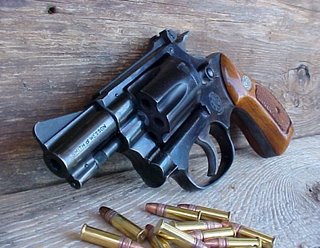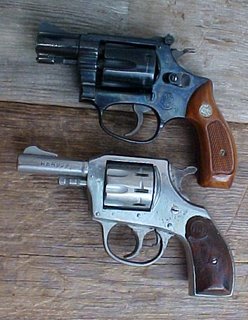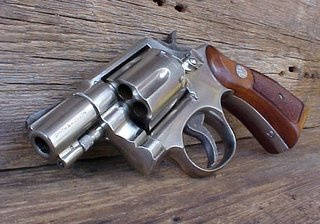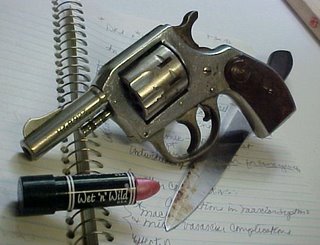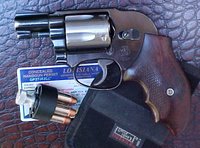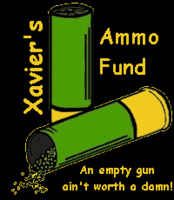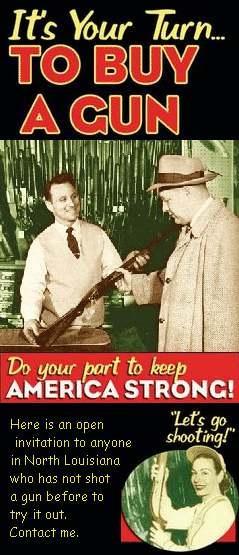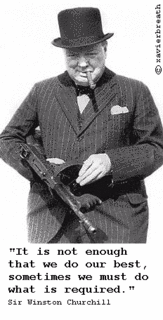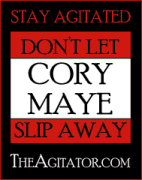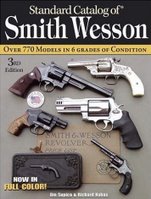Sayeth the seller:
"This auction is for a rare factory 3 inch S&W Model 49 Bodyguard. I have never seen an all original factory 3" Bodyguard offered for sale. This gun in in fantastic condition. It easily rates 99%. Please look closely at the pictures.

The only sign of use is a fine turn line. There are no shadows on the recoil shield and the case coloring on the trigger is vibrant. Any flaws you see in the pictures are either reflections or lint. The grips are also in near mint condition but do not number to the revolver. No box or accessories but I will include the original S&W factory historical letter that identifies this revolver as having shipped with a 3 inch barrel. I have no doubt that in a few years my price of $2499 will seem like a bargain basement price for this revolver."
A three inch Model 49 is indeed a rare gun. This particular one is lettered as being genuine. It is in great condition. The finish likely is 99%. The flatlatch makes it even more desirable.
The grips, however admittedly do
not number to this revolver. There is no box or papers. I give the seller a lot of credit for his honesty. Unscrupulous sellers have been known to stamp numbers into grips and have serial numbers magically appear on brand new box labels.
Now here is the goocher........a ANIB Model 49 with a two inch barrel lists at $400 in the
Standard Catalog of Smith & Wesson 3rd Edition. An "excellent" Model 49 lists at $350. Is an extra inch of barrel worth $2149?

As the photo to the left illustrates, I am a big fan of the Bodyguard frame. I believe it is the best pocket revolver ever designed, bar none. The only way to improve the gun was to make it lighter and stronger. If Smith & Wesson were to produce this frame in scandium, I might buy it today, regardless of the new gun price.
A buyer not only has to wonder if an extra inch of barrel is worth two grand, plus a Franklin and a half, but was it even a good decision when this revolver was special ordered? The Bodyguard revolver is a primo pocket gun, made for discreet, but instant self defense. It carries easily in a standard pocket by virtue of it's odd humpback shape. The shrouded hammer did allow single action as well as double action fire, but the real benefit of the Bodyguard frame is maintaining an upright and ready position all day long in a trouser pocket. These revolvers were not target guns, they were dedicated, life saving fighting guns. They were intended to be used at ranges under 20 feet, deployed swiftly from nowhere, and lit off at close range.
The three inch barrel would require a deeper pocket, and it would destroy the balance of the Bodyguard within the pocket, as well as slow the draw. The advantage of the three inch barrel is not in the increased sight radius for accuracy. If anything, the longer sight radius would be slower to come to sights if the sights were even going to be employed.
No, the advantage of the three inch barrel was a full length extractor rod, allowing for complete cartridge extraction and therefore greater insurance of a swift, sure reload.

To reload the gun, of course, one must carry the weight of extra cartridges in a speedloading device. It begs the question, however, if a rapid and certain reload is the goal, why not carry a pair of two inch Model 38 Airweight Bodyguards and employ the
New York reload? The total weight would be comparable to the heavier Model 49 and a prepared speedloader, the technique is faster, even more certain, and your pants are evenly weighted.
So getting back to the auction at hand.......I, personally, would not buy. The barrel length was an arguably poor decision when it was ordered, making the revolver an aberration, a deviation from a design that was at it's zenith. I give the seller kudos for honesty, but the revolver lacks original grips and the original box. That removes it from the collector realm, at least in that price range. The flatlatch and barrel length does make the revolver unusual and therefore desirable, but to me, it seems to be priced about two grand too high. Of course, the seller could be right, and a buyer may just be buying it a few years early at that price.
More on the S&W BodyguardLabels: Gun Auctions, Gun Tradin', Smith and Wesson, Snubbie Revolvers
 I purchased the little snubbie a few years back from CDNN. I think I paid about $230 for it. It looked like it had hit the concrete a few times, but the crown was good, and it shot reliably and as accurately as I could muster from any snubbie.
I purchased the little snubbie a few years back from CDNN. I think I paid about $230 for it. It looked like it had hit the concrete a few times, but the crown was good, and it shot reliably and as accurately as I could muster from any snubbie. 














